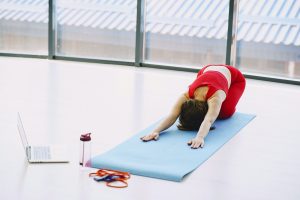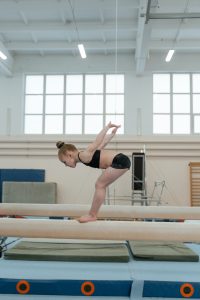Gymnastic equipment refers to the specialized apparatus used in the sport of gymnastics. These equipment are designed to facilitate and enhance various gymnastic movements, skills, and routines.
Gymnastics is a sport that involves a combination of strength, flexibility, balance, agility, coordination, and grace. It encompasses a wide range of physical activities and movements performed on various apparatuses or on the floor.
Gymnastics is known for its artistic and athletic nature, requiring discipline, focus, and precision.
Different disciplines of competitive gymnastics
See below;
Artistic Gymnastics
This is the most well-known and widely practiced form of gymnastics. It involves performing routines on different apparatuses such as the vault, uneven bars, balance beam, and floor exercise.
Artistic gymnasts showcase a variety of acrobatic and strength-based skills, jumps, spins, and choreographed movements.
Rhythmic Gymnastics
Rhythmic gymnastics combines elements of ballet, dance, and gymnastics. Gymnasts perform routines using apparatuses such as a rope, hoop, ball, clubs, or ribbon.
The routines focus on a combination of expressive movements, flexibility, and coordination while manipulating the apparatus.
Trampolining
Trampolining involves performing acrobatic moves and flips on a trampoline. Gymnasts use the bounce and elasticity of the trampoline bed to execute highly controlled and precise jumps, somersaults, twists, and other aerial maneuvers.
Acrobatic Gymnastics
Acrobatic gymnastics involves performing choreographed routines in pairs or groups. It emphasizes teamwork, balance, and lifts, with gymnasts executing various partner balances, pyramids, and dynamic tumbling sequences.
Gymnastic equipment for kids
When it comes to gymnastic equipment for kids, there are various options available depending on the age and skill level of the child. Here are some common pieces of gymnastic equipment suitable for kids:

- Balance Beam: A low-profile beam designed for practicing balance and coordination. Look for beams with a non-slip surface and adjustable heights.
- Gymnastics Mats: These provide a safe landing surface for various activities. Thick, cushioned mats are ideal for tumbling, flips, and landings.
- Mini Trampoline: Also known as a rebounder or mini-tramp, it allows kids to practice jumping, bouncing, and basic acrobatic skills while ensuring a softer landing.
- Horizontal Bar: A small, adjustable bar for practicing basic swinging and hanging skills. Make sure it is sturdy and can support the child’s weight.
- Vaulting Box: A padded box used for practicing jumps, vaults, and other gymnastic moves. It should be stable and have a non-slip surface.
- Rings: Suspended from a sturdy frame, rings help develop upper body and core strength. Ensure the rings are adjustable and suitable for kids.
- Parallel Bars: A set of bars used for developing strength, coordination, and basic bar skills. Look for adjustable bars that accommodate the child’s height.
- Climbing Rope: A rope hung from a secure structure, allowing kids to practice climbing, gripping, and upper body strength.

Precautions while using Gymnastic equipment for kids
Remember, safety is paramount when setting up gymnastic equipment for kids. Ensure the equipment is age-appropriate, well-maintained, and used under adult supervision. It’s also essential to provide ample space around the equipment to prevent accidents.
- Kids should always be supervised by a responsible adult while using gymnastic equipment. This ensures that they are using the equipment correctly and safely.
- Ensure that the equipment is suitable for the child’s age and skill level. Equipment designed for older or more advanced gymnasts may pose a higher risk for younger or inexperienced children.
- Set up the equipment according to the manufacturer’s instructions and ensure it is securely assembled. Regularly inspect the equipment for any signs of wear or damage, and promptly repair or replace any worn-out parts.
- Make sure the area around the equipment is clear of any obstacles or hazards. Remove furniture, toys, or other objects that could potentially cause a child to trip or collide with them.
- Place appropriate mats around and underneath the equipment to provide a cushioned landing surface. The mats should be thick enough to absorb impact and reduce the risk of injury.
- Use non-slip and shock-absorbing matting or flooring to enhance safety. This helps prevent slips and falls during activities and provides additional protection.
- Encourage kids to perform warm-up exercises and stretching routines before using the equipment. This helps prepare their muscles and joints for physical activity, reducing the risk of strains or sprains.
- Emphasize the importance of learning and practicing proper technique. Kids should progress gradually, mastering fundamental skills before attempting more advanced movements.
- Depending on the activity, consider using appropriate safety gear such as grips, wrist supports, or protective padding for vulnerable body parts. Consult with gymnastics professionals to determine the necessary safety equipment for specific exercises.
- Teach children about the importance of safety rules and proper behavior when using gymnastic equipment. Emphasize the significance of listening to instructions and using equipment only as intended.
Benefits of Gymnastic equipment for kids
Gymnastic equipment for kids offers numerous benefits for their physical, mental, and social development. Here are some key benefits:
Physical Fitness
Using gymnastic equipment helps improve overall physical fitness. It enhances strength, flexibility, coordination, balance, and agility. Regular practice on the equipment develops muscular strength and endurance, increases range of motion, and improves body control.
Motor Skill Development
Gymnastics equipment provides opportunities for kids to refine their motor skills. They learn to perform precise movements, develop body awareness, and improve their proprioception (sense of body position in space). These skills translate to improved performance in other sports and daily activities.
Confidence and Self-Esteem
As children master new skills and overcome challenges on the equipment, their confidence and self-esteem grow.
Achieving goals, learning routines, and performing in front of others contribute to a sense of accomplishment and self-assurance.
Discipline and Focus
Gymnastics requires discipline, focus, and concentration. Kids learn to follow instructions, pay attention to details, and practice with dedication. These skills transfer to other aspects of their lives, promoting discipline, focus, and a strong work ethic.
Cognitive Development
Gymnastics stimulates cognitive development in children. They learn to memorize routines, understand body mechanics, and solve movement puzzles. The mental challenges involved in gymnastics improve cognitive skills such as memory, problem-solving, and spatial awareness.
Social Interaction
Participating in gymnastics with other kids provides opportunities for social interaction, teamwork, and cooperation.
Kids learn to support and encourage their peers, work together in group routines, and develop social skills through shared experiences.
Body Awareness and Injury Prevention
Using gymnastic equipment helps children develop a strong sense of body awareness. They learn to control their movements, understand proper body alignment, and prevent injuries. This knowledge can benefit them in various physical activities and reduce the risk of accidents.
Fun and Enjoyment
Gymnastic equipment offers a fun and engaging way for kids to stay active and enjoy physical exercise. The thrill of learning new skills, the sense of achievement, and the joy of movement contribute to a positive and enjoyable experience.
A final thought about Gymnastic equipment for kids
Gymnastic equipment for kids serves as a valuable tool for their physical, cognitive, and social development.
It offers a platform for children to explore their physical abilities, enhance their skills, and build a strong foundation of strength, flexibility, coordination, and balance. The equipment promotes discipline, focus, and self-confidence as children overcome challenges, achieve goals, and master new skills.
Additionally, it provides an avenue for social interaction, teamwork, and the cultivation of essential social skills.
By providing a safe and supportive environment with age-appropriate equipment, we empower children to enjoy the benefits of gymnastics while fostering a lifelong love for physical activity and overall well-being.
One comment
Comments are closed.